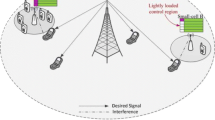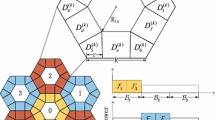Abstract
Heterogeneous cellular networks that consist of macrocells and small cells can offer significant capacity gain by utilizing the resources of the small cells. However, for this purpose, the interference between the macrocells and the small cells should be carefully managed. In this paper, we propose two types of uplink inter-cell interference control schemes: handover-assisted bandwidth-splitting and quality-of-service (QoS)-aware power-splitting. The bandwidth-splitting interference control scheme is a win–win strategy that enhances the rates of both interfering user and interfered user via handover and frequency partitioning. On the other hand, the power-splitting interference control scheme is a yield-win strategy that enhances the rate of interfered user while reducing the rate of interfering user via message and power partitioning. Each scheme has its own operation region. The bandwidth-splitting scheme can be employed when the interfering user is located in the outer cell region having low signal-to-noise ratio (SNR), whereas the power-splitting scheme can be employed when the interfering user is located in the inner cell region having high SNR. We also propose an operational framework with low feedbacks and computational complexity. Simulation results show that the proposed controls significantly reduce interference while guaranteeing the target user QoS at best; therefore, they provide enhanced rate distribution, average ergodic rate and outage ratio under the typical target rate and range expansion bias, as compared to legacy interference control schemes.











Similar content being viewed by others
References
Xia, P., Chandrasekhar, V., & Andrews, J. G. (2010). Open vs. closed access femtocells in the uplink. IEEE Transactions on Wireless Communications, 9(12), 3798–3809.
Tropos Networks (Mar 2007). Pico-cell mesh: Bringing low-cost coverage, capacity and symmetry to mobile WiMAX. In A tropos networks white paper.
Gu, L. G., Garcia, Z. I., Pedersen, K. I., Costa, G. W., & Mogensen, P. E. (2012). Autonomous component carrier selection: Interference management in local area environments for LTE-advanced. IEEE Journal on Selected Areas in Communications, 30(3), 525–537.
Chen, Z., & Lin, T. (July 2013). A novel component carrier selection algorithm for LTE-advanced heterogeneous networks. In Proceedings of IARIA Internet.
Qualcomm Europe (Oct 2009). R1-094225: DL performance with hotzone cells. In 3GPP TSG-RAN WG1 meeting #58bis.
LG Electronics (Aug 2010). R1-104661: Comparison of time-domain eICIC solutions. In 3GPP TSG RAN1 meeting #62.
Noh, W., Shin, W., Choi, H., Shin, C., & Jang, K. (Apr 2012). Distributed frequency resource control for inter-cell interference control in heterogeneous cellular networks. In Proceedings of IEEE WCNC.
Chen, Z., Lin, T., & Din, D. (Feb 2015). Multi-tone almost blank subframes for enhanced inter-cell interference coordination in LTE HetNets. In Proceedings of IEEE ICNC.
Gomadam, K. S., Cadambe, V. R., & Jafar, S. A. (Nov 2008). Approaching the capacity of wireless networks through distributed interference alignment. In Proceedings of IEEE globecom.
Huang, C., Cadambe, V. R., & Jafar, S. A. (June 2009). Interference alignment and the generalized degrees of freedom of the X channel. In Proceedings of IEEE ISIT.
Shin, W., Noh, W., Choi, H., & Jang, K. (2012). Hierarchical interference alignment for downlink heterogeneous networks. IEEE Transactions on Wireless Communications, 11(12), 4549–4559.
Han, T. S., & Kobayashi, K. (1981). A new achievable rate region for the interference channel. IEEE Transactions on Information Theory, 27(1), 49–60.
Etkin, R., Tse, D., & Wang, H. (2008). Gaussian interference channel capacity to within one bit. IEEE Transactions on Information Theory, 54(12), 5534–5562.
Yu, C., & Tirkkonen, O. (Sept 2010). Distributed inter-cell interference coordination based on rate-splitting. In Proceedings of IEEE ISWCS.
Zhou, G., Bauch, G., & Berkmann, J. (Oct 2012). Inter-cell interference coordination via cooperative rate splitting and scheduling. In Proceedings of IEEE WiMob.
Zhou, G., Xu, W., & Bauch, G. (Oct 2012). Interfernce mitigation with rate splitting in multi-cell wireless networks. In Proceedings of IEEE WiMob.
3GPP Long Term Evolution (Oct 2009). Heterogeneous networks: General overview. R1-094224.
Okino, K., Nakayama, T., Yamazaki, C., Sato, H., & Kusano, Y. (June 2011). Pico cell range expansion with interference mitigation toward LTE-advanced heterogeneous networks. In Proceedings of IEEE ICC
Yu, W., Kwon, T., & Shin, C. (2013). Multicell coordination via joint scheduling, beamforming and power spectrum adaptation. IEEE Transactions on Wireless Communications, 12(7), 1–14.
Nguyen, D. H., & Le-Ngoc, T. (2013). Joint beamforming design and base-station assignment in a coordinated multicell system. IET Communications, 7(10), 942–949.
Choi, D., Monajemi, P., Kang, S., & Villasenor, J. (Nov 2008). Dealing with loud neighbors: The benefits and tradeoffs of adaptive femtocell access. In Proceedings of IEEE globecom.
Chandrasekhar, V., & Andrews, J. G. (2009). Uplink capacity and interference avoidance for two-tier femtocell networks. IEEE Transactions on Wireless Communications, 8(7), 3498–3509.
Courant, R., & John, F. (1989). Introduction to calculus and analysis. Berlin: Springer.
Boyd, S., & Vandenberghe, L. (2004). Convex optimization. Cambridge: Cambridge University Press.
Xi, W., Yun, X., Nagata, S., Kishiyama, Y., & Chen, L. (June 2013). An enhanced interference measurement scheme for CoMP in LTE-advanced downlink. In Proceedings of IEEE ICC.
3GPP (Mar 2010). Further advancement for E-UTRA physical layer aspects. TR.36.814.
Author information
Authors and Affiliations
Corresponding author
Rights and permissions
About this article
Cite this article
Noh, W., Shin, W., Lee, T. et al. Distributed uplink interference control based on resource splitting in heterogeneous cellular networks. Wireless Netw 23, 625–640 (2017). https://doi.org/10.1007/s11276-016-1364-2
Published:
Issue Date:
DOI: https://doi.org/10.1007/s11276-016-1364-2




